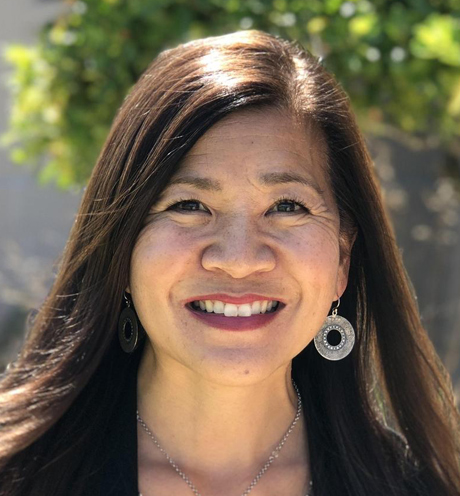
t is 15 minutes before the first bell rings at Central Coast High School — an alternative school along the Central Coast overlooking Monterey Bay in Seaside, California — and the school is bustling with students arriving early to socialize, talk with their favorite teachers or receive extra academic supports, and eat breakfast in the newly created “Student Lounge and Career Center,” a space that evolved from a classroom into a warm, welcoming environment thanks to staff and student creativity and outside donations.
The school still has ways to go, but this is a vast improvement over three years ago when many students struggled with arriving late or missing first period all together.
Central Coast High School, along with the Community Day School and Independent Study, are part of the Monterey Peninsula Educational Options Program. Central Coast High School is a continuation school serving 11th- and 12th-graders not on track for graduation. The Community Day School has two classrooms that serve middle and high school students who have been expelled or referred due to extreme behavior. Lastly, Independent Study serves students ranging from kindergarten to 12th grade who are looking for flexibility and an alternate approach to learning.
Home to 112 students — of which 79 percent qualify for the free and reduced-meal program, 56 percent have a primary language of Spanish, and 20 percent are English learners — Central Coast High School has raised the bar on alternative education. The school recently made headlines as a 2018 designated model continuation school by the California Department of Education, and its principal, Alan Crawford, was recently named the Association of California School Administrators Region 10 Educational Options Administrator of the Year for 2018–19. The model continuation school designation resulted from forward-thinking initiatives such as a new master schedule, new career academies and increased opportunities for credit recovery.
In just three short years, Central Coast High School and Community Day School have changed the way they are educating their student bodies. Under the leadership of Superintendent PK Diffenbaugh, MPUSD’s secondary schools were challenged in 2015 to reimagine how they would deliver instruction as part of a “moonshot-thinking” process. (Moon-shot thinking evolved when then President John F. Kennedy said, “We choose to go to the moon not because it is easy, but because it is hard.”) In a 2015 op-ed in the local newspaper, Dr. Diffenbaugh wrote: “The world is changing rapidly. Today, educators are preparing students to solve social, political and health problems yet to be discovered, use technologies that haven’t been invented, and compete for jobs that are not even created. Education must be reimagined and transformed if we are to prepare all students for the challenges and opportunities ahead.”

Administration, teachers and staff tackled this challenge with voracity and focused on strengthening student–staff relationships, leveraging student voice, embracing trauma-informed practices that resulted in the hiring of an additional full-time mental health professional, and looking at all aspects of instruction and structures using the question: What is best for students?
Building partnerships with external third-party partners was critical, and, as a result, students at the Community Day High School, for example, engage in a weekly restorative justice circle facilitated by a local nonprofit and are able to attend the local athletics and sports center two days a week to focus on physical and wellness education. Relevance and engagement are site priorities, and each week, Community Day High School students partner with the Bureau of Land Management at the Fort Ord National Monument and the mayor of the City of Marina to engage in plant restoration, while simultaneously learning about local and indigenous plants (the program was recently recognized and honored locally). At Central Coast High School, an additional work-based learning opportunity involves a partnership with Paxton Patterson Laboratories to build a lab where students visit and are exposed to health careers through hands-on learning. Lastly, this school year, Educational Options has partnered with Dr. Doug Reeves, Lisa Almeida and the team at Creative Leadership Solutions to implement effective assessment practices, which staff credit as one of the primary reasons for a 76.5 percent decrease in D’s and F’s in Semester 1 of this year compared to last school year.
What makes the school so successful is the ability of administration, teachers and staff to fully understand the school’s vision and to focus on implementing the key priorities well. Buy-in from all levels of the administration, including the school board, has also been important.
“Our board of education is extremely proud of the incredible work that our administrators and staff are engaging in with our most vulnerable students,” said Bettye Lusk, MPUSD board member and CSBA Director-at-Large, African American. “Our students deserve our very best, and our alternative programs have made remarkable gains to ensure they are set up for academic success.”
While Principal Crawford and Assistant Principal David Diehl lead the Educational Options Program, they practice distributive leadership, allowing all staff to take ownership and engage their colleagues in deep learning and a process of continuous improvement that eventually lead to the creation of a new vision statement: “Where Your Past Will Not Define your Future.” The word ”future” also references the key values of the school’s Positive Behavioral Intervention and Support system, which is based on family, unity, trust, understanding, respect and empathy.
The reimagining process that CCHS began could not have been done without the leadership of key staff. Besides looking at instruction, the team wanted to change the narrative on what a continuation school looked and felt like, as well as how it was perceived by stakeholders. The team explicitly focused on strategic communication and addressed the connotation of how people perceive a continuation school. The schools in the Educational Options Program are now becoming schools of choice that not only help students who are not on track to graduate, but also serve those students who truly need and desire a different approach to education. As staff reflected on current practice and looked at educating and engaging students with the “what is best for our kids” approach, a few key concepts emerged:
Flexible Schedule: Students were arriving to campus 30 or more minutes late. Staff surveyed students as to why, and later determined that their particular student body could benefit from a later school start time. After negotiations with the school district and bargaining units, the school was able to adjust the schedule in response to student feedback. Soon after the schedule was adjusted, staff began to see a shift in culture and, despite the later start time, noticed students were arriving early to socialize and even take advantage of breakfast before school. The school partnered with the district’s Nutrition Services department to provide breakfast access to students before first period, and reached out to teachers to provide opportunities for before-school support on their academics.
Credit Recovery: Before the reimagining process, most students earned between 35 to 45 credits a semester solely utilizing a tradition schedule and an online learning platform. However, a recent shift to an eight-period day with an alternating day schedule where some classes are every day and others are every other day, along with the addition of using the Adult School for concurrent enrollment credit recovery, has allowed some students to earn up to 60 credits a semester. Further, teachers moved credit recovery from a sole reliance on the online learning platform to a focus on teacher-directed, project-based learning using technology-based Google classroom modules and other engaging hands-on projects using different media and technology. The ability to earn additional credits has accelerated the time period in which students can return to their home high school; however, the positive school culture at CCHS school culture is such that many students elect to stay at Central Coast to complete their high school career.
Career Technical Pathways: Perhaps the most unique concept at Central Coast is the offering of three career pathways in patient care; food service and hospitality; and public safety. The school understands the importance of preparing for life beyond high school, and the career pathway academies engage students and allow them to explore various occupations while earning high school credits. Additionally, the career pathways can be continued at neighboring Monterey Peninsula College. It is through this experience that Central Coast High students acquire valuable knowledge and skills that will enhance their employment opportunities as they transition from high school to career or college.
The patient care academy offers hands-on learning environments for students interested in healthcare professions. The program partners with local hospitals to create work-based learning opportunities to students. The food service and hospitality academy offers students a working knowledge of many different segments of the service industry. Students receive hands-on learning in the school’s kitchen (currently being rebuilt as a state-of-the-art kitchen with new school bond money) and participate in regular learning experiences at hospitality businesses. The public safety academy brings real-world experience into the classroom and draws upon criminology, corrections, sociology, psychology and law. It incorporates speakers, tours and experiences with working criminal justice professionals to help students prepare for careers in law enforcement, corrections, private security and loss prevention.
While site leaders and staff at the Educational Options Program would be the first to tell you that many challenges still remain and the arrival to the metaphorical moon is still distant, it is clear that the work that has transpired has had a tremendous impact on the lives of students who deserve the most their schools can give them.
To learn more about Central Coast High School, visit www.mpusd.net.
Marci McFadden is the chief of communications and engagement for Monterey Peninsula USD, where she oversees the district’s internal and external communications.